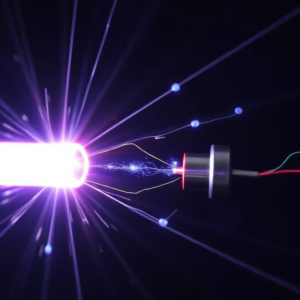The photoelectric effect is a phenomenon where light (or other electromagnetic radiation) hits a material, causing it to release electrons. In simple terms, when light shines on certain materials, it can “knock” electrons out of the material, which is important in many electronic devices like solar cells and photodetectors.

Here’s how it works in a simple way:
- What is Light? Light is made up of tiny particles called photons. Photons carry energy, and the amount of energy depends on the color (or wavelength) of the light. For example, blue light has more energy than red light.
- What Happens During the Photoelectric Effect? When light hits a material, usually a metal, the energy from the photons is transferred to the electrons in the material. If the photons have enough energy, they can knock the electrons out of the material. The ejected electrons are called photoelectrons.
- Conditions for the Photoelectric Effect to Happen:
- The light must have enough energy to release electrons. This depends on the frequency (color) of the light.
- If the light is too weak or has low energy (like dim red light), it may not have enough power to release electrons.
- If the light is strong enough (like bright blue or ultraviolet light), it can release electrons.
- Energy and Frequency:
- The energy of the photon is directly related to the frequency of the light. High-frequency light (like ultraviolet or blue light) has more energy per photon, so it’s more likely to release electrons.
- Low-frequency light (like red or infrared) has less energy and may not be able to release electrons unless it’s very intense.
- The Basic Process:
- Light hits the surface of a material (usually metal).
- The energy from the photons is absorbed by electrons in the material.
- If the energy is enough, the electrons are ejected from the surface.
- Why is the Photoelectric Effect Important in Electronics? The photoelectric effect is the basis for many modern technologies:
- Solar Cells: Solar panels work by using the photoelectric effect to convert light energy into electrical energy. The sunlight hitting the solar cell knocks electrons loose, creating a flow of electricity.
- Photodetectors: Devices like cameras or light sensors use the photoelectric effect to detect light and convert it into an electrical signal.
- Light Meters: Light meters, which measure the intensity of light, use the photoelectric effect to generate a signal based on how much light is hitting a sensor.
- Key Points to Remember:
- The photoelectric effect shows that light is made up of particles (photons), not just waves, and this was a major discovery in physics.
- The energy of the light must be high enough to release electrons from the material.
- This effect is widely used in various electronic devices to convert light into electrical signals.
Example:
Imagine a solar panel. When sunlight (which is made up of photons) shines on the panel, the energy from the photons knocks electrons loose from the material (often silicon) in the panel. These free electrons flow through the material, creating an electric current that powers devices.
In Summary:
The photoelectric effect is the process where light hits a material and causes it to release electrons. This effect is used in many modern electronic devices, including solar cells and cameras, to convert light energy into electrical energy or signals. The key idea is that light can behave like tiny particles (photons) that can transfer energy to electrons and “knock” them loose from a material.
Keywords: photoelectric, Electronics











